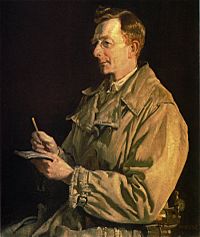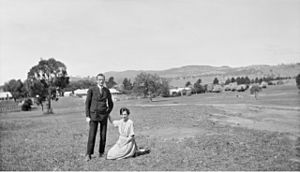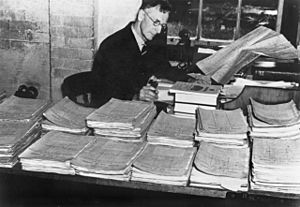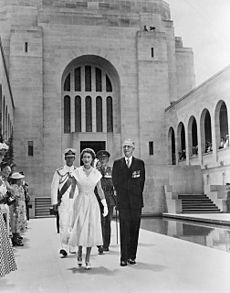Charles Bean facts for kids
Quick facts for kids
Charles Bean
|
|
|---|---|

Portrait by George Lambert, 1924
|
|
| Born |
Charles Edwin Woodrow Bean
18 November 1879 |
| Died | 30 August 1968 (aged 88) |
| Awards | Chesney Gold Medal (1930) |
| Academic background | |
| Alma mater | University of Oxford |
| Influences | Banjo Paterson |
| Academic work | |
| Main interests | Australian military history First World War |
| Notable works | Official History of Australia in the War of 1914–1918 |
| Influenced | Gavin Long Bill Gammage |
Charles Edwin Woodrow Bean (born 18 November 1879 – died 30 August 1968) was an Australian war correspondent and historian. He is often known as C. E. W. Bean.
Bean is famous for editing the 12-volume Official History of Australia in the War of 1914–1918. He also played a huge part in creating the Australian War Memorial. He helped make the ANZAC legend popular, which is about the bravery and mateship of Australian and New Zealand soldiers.
Contents
Early Life and Education
Charles Bean was born in Bathurst, New South Wales, Australia. His father, Edwin Bean, was a headmaster. In 1889, when Charles was ten, his family moved to England.
He went to school in England, first at Brentwood School. Later, he studied at Clifton College in Bristol. In 1898, he won a scholarship to Hertford College, Oxford, a famous university. He earned degrees there and became a lawyer in 1903.
Early Career as a Journalist
Bean returned to Australia in 1904. He worked as a teacher for a short time. From 1905 to 1907, he was a legal assistant.
In 1908, he joined The Sydney Morning Herald newspaper as a reporter. He wrote many articles about his travels in the Australian outback. One of his well-known books from this time was Dreadnought of the Darling.
From 1911 to 1912, Bean was the Herald's correspondent in London. He wrote a series of articles that became his book Flagships Three.
World War I
When World War I began in August 1914, Charles Bean became the official war correspondent for the Australian Imperial Force (A.I.F.). He was chosen by Australian journalists. He was given the rank of captain in the A.I.F. He reported on all the major battles where Australian troops fought.
Gallipoli Campaign
Bean landed at Anzac Cove on the Gallipoli Peninsula on 25 April 1915. This was just a few hours after the first Australian troops arrived. He sent reports about the Australians' experiences during most of the campaign.
His reports were very detailed and accurate. However, some newspapers found his writing style less exciting than other war correspondents.
In May 1915, Bean went to Cape Helles with the 2nd Infantry Brigade. He was covering the Second Battle of Krithia. He found himself under enemy fire for the first time. He helped wounded soldiers and carried messages. He was even recommended for an award for his bravery, but he couldn't receive it because his military rank was only honorary.
On 6 August 1915, Bean was shot in the leg by a Turkish bullet. This happened during the Battle of Sari Bair. Even with his wound, he refused to leave. He continued to report on the final stages of the Gallipoli campaign. He left Gallipoli just before the final evacuation of Anzac Cove in December 1915.
Western Front
In 1916, Bean moved with the Australian Imperial Force to France. This was after the Gallipoli campaign ended. He reported from almost all the battles involving Australian troops on the Western Front. He saw firsthand how difficult it was to communicate during battles. He also saw the challenges of coordinating different parts of the army.
Bean also noticed how hard it was to get accurate information from soldiers on the front line. They often had a limited view of the battlefield. He also saw the effects of shell-shock from the heavy artillery fire.
During his time on the Western Front, Bean started thinking about preserving Australia's war experiences. He wanted to create a permanent museum and national war memorial. He also wanted to collect records of the events. In 1917, the Australian War Records Section was set up. Its job was to collect documents and important items related to the war.
Bean had a strong influence on the Australian war effort. He sometimes disagreed with military leaders. For example, he had concerns about General John Monash being appointed to lead the Australian Corps in 1918. Bean preferred other commanders. However, he later admitted that Monash was very successful in the role. Bean's own brother served as a doctor in the Medical Corps on the Western Front.
Post-war Work

After the war, Bean worked hard to get access to British war records. This was important for his historical work. It took him six years to get permission and three more years to copy all the documents. This gave him resources that other historians did not have.
Bean was very dedicated to his work and wouldn't change his views for personal gain. He was not influenced by criticism from British historians. He was even offered a knighthood many years later, but he turned it down.
In 1919, Bean led the Australian Historical Mission back to Gallipoli. He walked over the battlefields, like Lone Pine and the Nek. He even found the bones of soldiers who had died there. He also arranged for German aircraft to be brought back to Australia for the future museum.
When he returned to Australia in 1919, Bean began working on the Official History of Australia in the War of 1914–18. He worked with a team of researchers. The first volume was published in 1921. It took 21 years for all 12 volumes to be published. Bean himself wrote the first six volumes, which covered the Army's involvement. In 1946, he published Anzac to Amiens, which was a shorter version of the Official History.
Bean's way of writing war history was unique. He focused on both the "little people" (individual soldiers) and the big events of the war. Because the Australian Army was smaller, he could describe the actions of many individuals. This fit Bean's idea that the Australian Army's success was thanks to these individuals, not just generals or politicians.
Bean was also very interested in the Australian character. He used his history to describe an ideal view of Australians. He believed they were brave and strong. He wrote that it was "character" that made soldiers rush the hills at Gallipoli and hold on.
Bean's approach was to carefully record and analyze what happened. He described the wider war, then the detailed plans for each battle. He included the views of Australian commanders and compared them with what soldiers on the front line experienced. He even used German or Turkish records. He also reported on his own involvement in decisions, even criticizing himself with hindsight (looking back and knowing more).
Bean's writing style greatly influenced later Australian war historians. They continued his focus on telling the stories of individuals alongside the larger history.
Australian War Memorial
Charles Bean played a key role in creating the Australian War Memorial. After experiencing World War I, he wanted to build a place to display war items and photos. He spent a huge part of his life developing the Memorial in Canberra. Today, it is one of Australia's most important cultural places.
Bean's dream was for a memorial that would keep records and items from the war. It would also honor Australians who died fighting for their country. In 1917, because of Bean's ideas, the Australian War Records Section was created. This group collected items from the battlefield and hired war photographers and artists. Many of these items and artworks are now at the Memorial.
The main building of the Australian War Memorial was finished in 1941. It was designed to be an impressive monument. Bean's dream of a memorial for Australian soldiers had come true. Later, it was decided that the Memorial would also honor those who served in World War II.
The Hall of Memory, completed in 1959, perfectly fulfilled Bean's vision. He believed that war should not be glorified. Instead, those who died fighting should be remembered. Bean's strong beliefs, like not speaking badly about the enemy, greatly shaped the way the Australian War Memorial works even today.
- With the flagship in the South (1909)
- On the Wool Track (1910)
- The Dreadnought of the Darling (1911)
- Flagships Three (1913)
- The Anzac Book (Ed., 1916)
- Letters from France (1917)
- In Your Hands, Australians (1918)
- Official History of Australia in the War of 1914–1918
-
- Volume I – The Story of Anzac: the first phase (1921)
- Volume II – The Story of Anzac: from 4 May 1915 to the evacuation (1924)
- Volume III – The Australian Imperial Force in France: 1916 (1929)
- Volume IV – The Australian Imperial Force in France: 1917 (1933)
- Volume V – The Australian Imperial Force in France: December 1917 – May 1918 (1937)
- Volume VI – The Australian Imperial Force in France: May 1918 – the Armistice (1942)
- (Six other volumes were written by other authors, with Bean helping to guide them.)
- Anzac to Amiens (1946)
- Here, My Son (1950)
- Two Men I Knew (1957)
Personal Life
Charles Bean married Ethel Clara "Effie" Young on 24 January 1921. She passed away in the 1990s.
Images for kids






